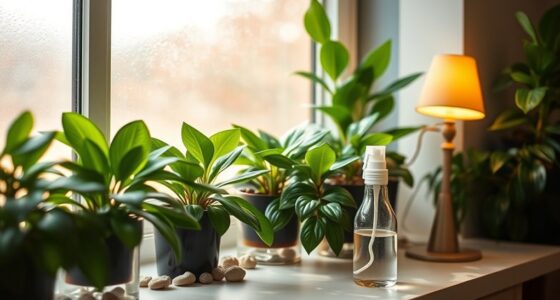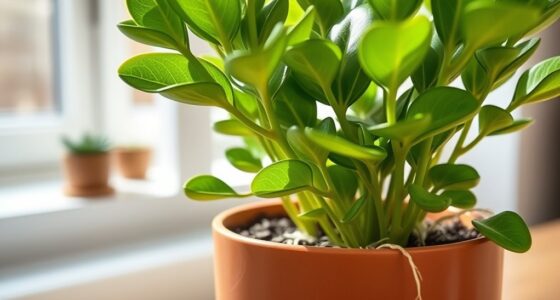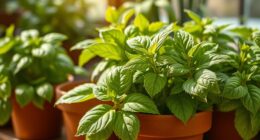If your houseplant’s leaves turn yellow, start by checking your watering habits—overwatering or underwatering can stress roots and cause yellowing. Make sure the soil drains well and isn’t too acidic or alkaline, which can hinder nutrient uptake. Also, look for pests or disease, and check if environmental conditions like light, drafts, or temperature are suitable. Proper care and adjustments can often fix the issue—keep exploring to learn more about keeping your plants healthy.
Key Takeaways
- Check watering habits to prevent overwatering or underwatering, which can cause root stress and yellowing leaves.
- Inspect roots for damage, rot, or compaction, and repot if necessary to restore healthy nutrient uptake.
- Test and adjust soil pH and fertilization to address deficiencies and improve nutrient absorption.
- Ensure adequate lighting, stable temperatures, and humidity levels to reduce environmental stressors.
- Look for pests or diseases and treat promptly with appropriate organic or chemical controls to prevent leaf yellowing.
Poor Drainage or Improper Watering
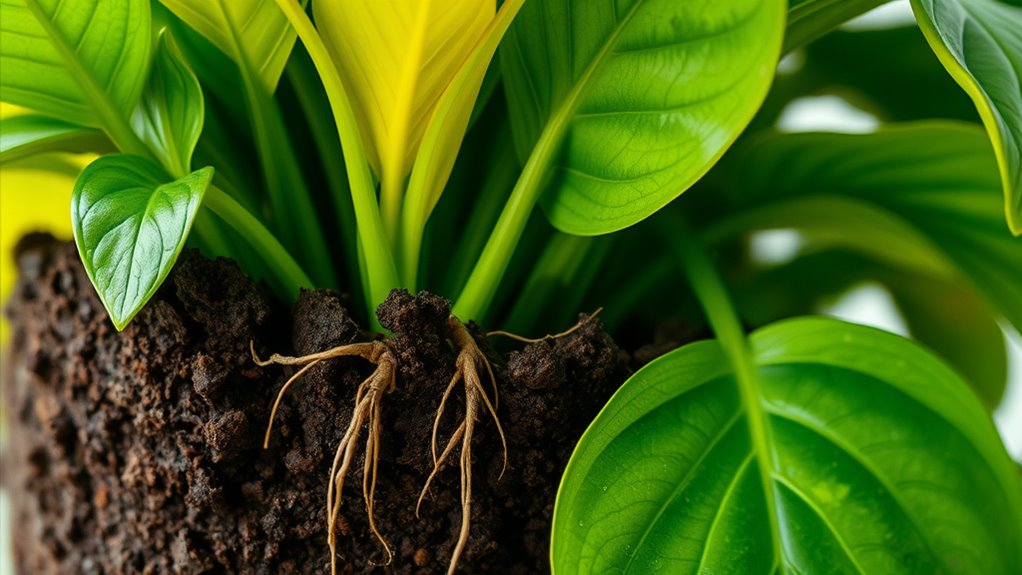
Poor drainage or improper watering is a common cause of yellow leaves on houseplants. When soil doesn’t drain well due to poor drainage or lack of drainage holes, water can accumulate, creating waterlogged soil that suffocates roots and promotes root rot. Ensuring your soil has proper drainage properties can help prevent these issues. Overwatering keeps soil constantly moist, leading to moisture stress and yellowing foliage, while underwatering prevents roots from absorbing nutrients, also causing leaves to yellow. To prevent this, check soil moisture regularly with a finger test or moisture meter, watering only when the top inch feels dry. Use well-draining soil mixes and containers with drainage holes to facilitate proper water flow. Avoid excess water in saucers or trays by always emptying them, and follow a consistent watering schedule tailored to your plant’s needs. Incorporating appropriate watering techniques can also significantly improve plant health. Additionally, ensuring proper air circulation around your plants can help prevent excess moisture buildup and reduce the risk of issues like root rot, and improved airflow can promote healthier, greener foliage. Maintaining good soil aeration is also essential for healthy root development and overall plant vitality.
Root Damage or Compacted Roots
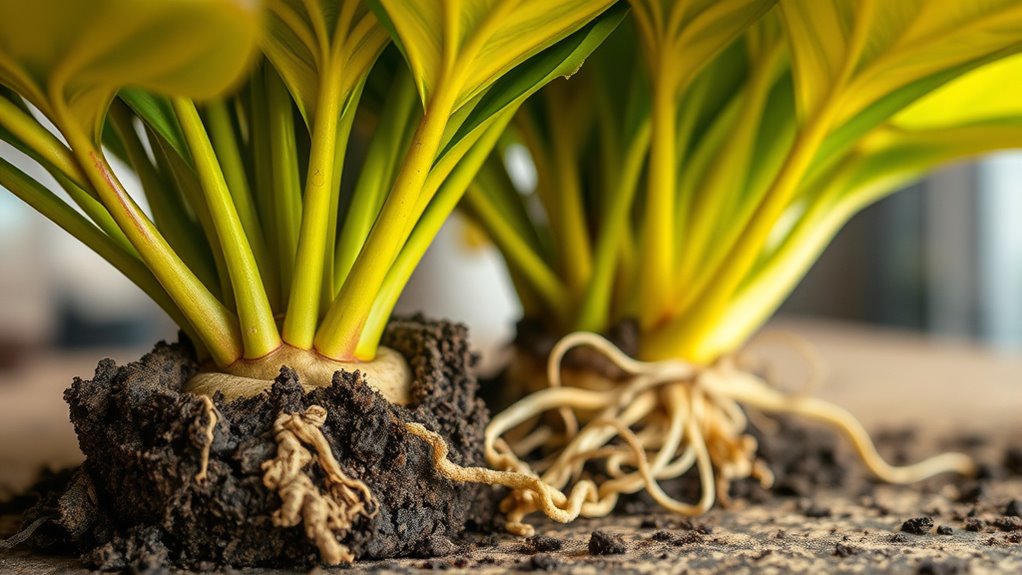
When houseplants develop yellow leaves despite proper watering, root issues might be to blame. Root damage from tools, disease, or root rot hampers nutrient absorption, leading to yellowing leaves. Compacted soil restricts soil drainage, oxygen, and water movement, causing root congestion and declining root health. If roots are circling or unhealthy, they can’t support the plant properly. To diagnose, gently remove the plant for root inspection. Healthy roots are whitish-yellow and firm; unhealthy roots are brown, mushy, and foul-smelling. Repotting in fresh soil and pruning dead roots can restore health. Additionally, using drainage systems can help prevent future issues. Here’s a quick guide:
| Root Condition | What to Do |
|---|---|
| Root circling | Repot with new soil, prune circling roots |
| Root rot | Remove affected roots, repot in well-draining soil |
| Unhealthy roots | Trim, improve soil drainage |
| Healthy roots | Maintain proper watering and repotting |
Inappropriate Soil Ph and Nutrient Deficiencies
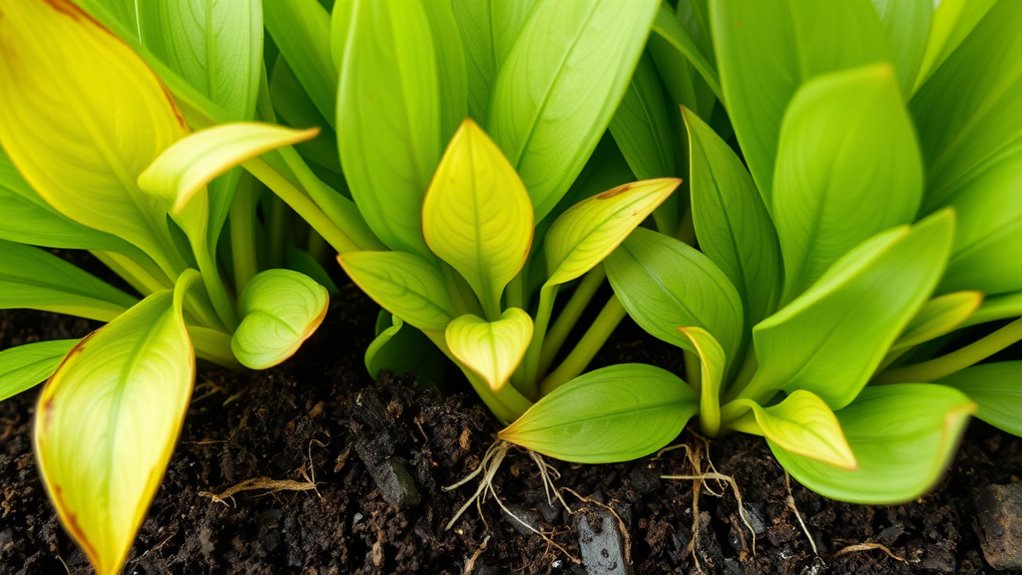
Your houseplants need soil with a pH between 6.0 and 7.0 to absorb nutrients properly. If the soil’s too acidic or alkaline, essential nutrients like iron and magnesium become unavailable, causing yellowing leaves.
Testing and adjusting the soil pH can often restore vibrant, healthy foliage.
Optimal Soil Ph Range
Maintaining the proper soil pH is essential for your houseplants to absorb nutrients effectively. Most thrive in a soil pH range of 6.0 to 7.0, where nutrient availability is at its best. If the soil becomes too acidic (below 6.0), nutrient uptake is hindered, leading to yellow leaves. Conversely, alkaline soil (above 7.0) can cause deficiencies of micronutrients like iron. Regular soil testing helps you determine whether amendments are needed, such as sulfur to lower pH or lime to raise it. Understanding the soil pH range guarantees your plants access vital nutrients, preventing deficiencies. Use the table below for clarity:
| Soil pH | Nutrient Availability | Common Issues |
|---|---|---|
| <6.0 | Limited micronutrients | Acidic soil, yellowing |
| 6.0-7.0 | Ideal nutrient uptake | Healthy foliage |
| >7.0 | Micronutrient deficiencies | Alkaline soil, yellowing |
Being aware of the soil pH and its impact on nutrient availability is crucial for maintaining healthy houseplants. Monitoring soil pH levels regularly can help you prevent nutrient imbalances and keep your plants thriving. Additionally, understanding how soil acidity influences nutrient absorption can further enhance your ability to care for your plants effectively. Proper soil amendments can restore optimal pH levels, ensuring your houseplants remain healthy and vibrant.
Nutrient Deficiency Signs
Identifying nutrient deficiencies through leaf yellowing patterns is essential for diagnosing soil and fertilization issues. Yellowing leaves can indicate a nutrient deficiency, but the pattern helps pinpoint the specific problem. A home theatre projector can enhance your viewing experience at home, but proper maintenance is necessary to keep it functioning well. Recognizing these signs of deficiency allows you to adjust your plant nutrients and fertilization schedule accordingly. Addressing soil pH imbalances promptly is crucial for ensuring nutrient uptake and preventing further yellowing. Maintaining a healthy plant involves addressing these issues promptly to prevent further yellowing and promote robust growth. Additionally, understanding the vibrational energy of your plants and environment can support overall health and vitality. Regularly monitoring soil conditions and making adjustments based on plant health indicators can help maintain optimal growth conditions.
Environmental Factors: Light, Drafts, and Temperature
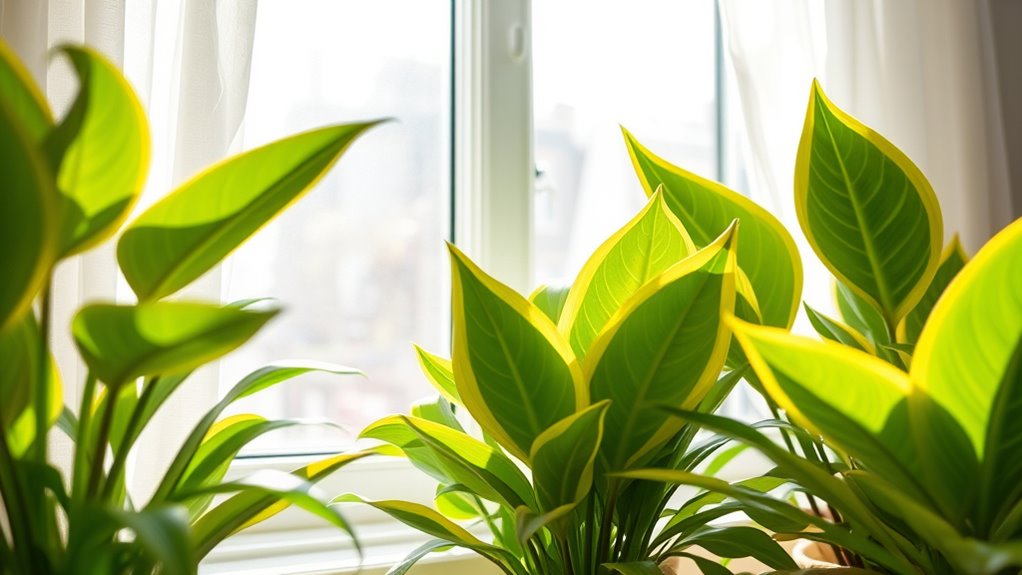
Environmental conditions play a crucial role in the health of your houseplants. Poor lighting, drafts, and temperature fluctuations can cause significant environmental stress, leading to leaf yellowing. To understand this better, consider:
- Insufficient light dimming indoor plants’ leaves, especially on lower foliage.
- Cold drafts from windows or air vents causing transparent spots or browning.
- Sudden temperature drops triggering leaf drop and stress.
- Humidity levels that are too low, increasing plant stress and yellowing.
Maintaining consistent temperatures and avoiding cold drafts helps prevent leaf yellowing. Proper lighting ensures plants thrive, while stable environments reduce stress. Monitoring air quality indicators can also help identify environmental stressors affecting your plants.
Increasing humidity and protecting plants from drafts support healthy, green foliage, making your indoor plants less susceptible to environmental stress.
Pests, Diseases, and Viral Infections
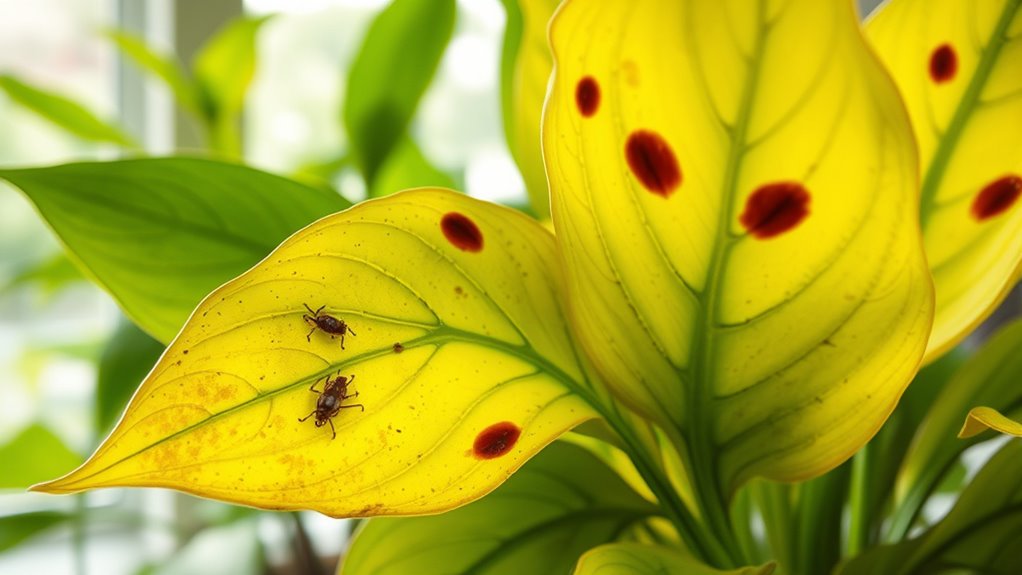
Pests, diseases, and viral infections can quickly undermine your houseplants’ health if left unchecked. Pests like spider mites, aphids, mealybugs, and scale feed on plant sap, causing leaf yellowing and often leaving webbing or sticky residue. Look for leaf spots, distorted growth, or small holes as signs of infestation. Using vetted plant pest control products can effectively manage these issues without harming your plants. Viral infections may cause blotchy, mottled yellow patches, deformed leaves, and discolored flowers, spreading rapidly if ignored. To prevent further damage, quarantine affected plants and sterilize tools before treatment. Employing integrated pest management strategies can help reduce pesticide dependency and promote healthier plants. Using biological controls like beneficial insects can also be an eco-friendly way to manage pest populations. Use insecticidal soap or neem oil to control pests and fungal diseases. Ensuring proper air circulation and avoiding overhead watering can also significantly lower the risk of leaf spots and other infections. Proper watering techniques and avoiding overwatering help prevent root rot and other moisture-related problems that can weaken plants’ defenses. Good plant care practices, including maintaining optimal humidity and light levels, help bolster your plants’ natural defenses. Prompt action keeps your houseplants vibrant and healthy.
Stress From Repotting and Plant Adjustment
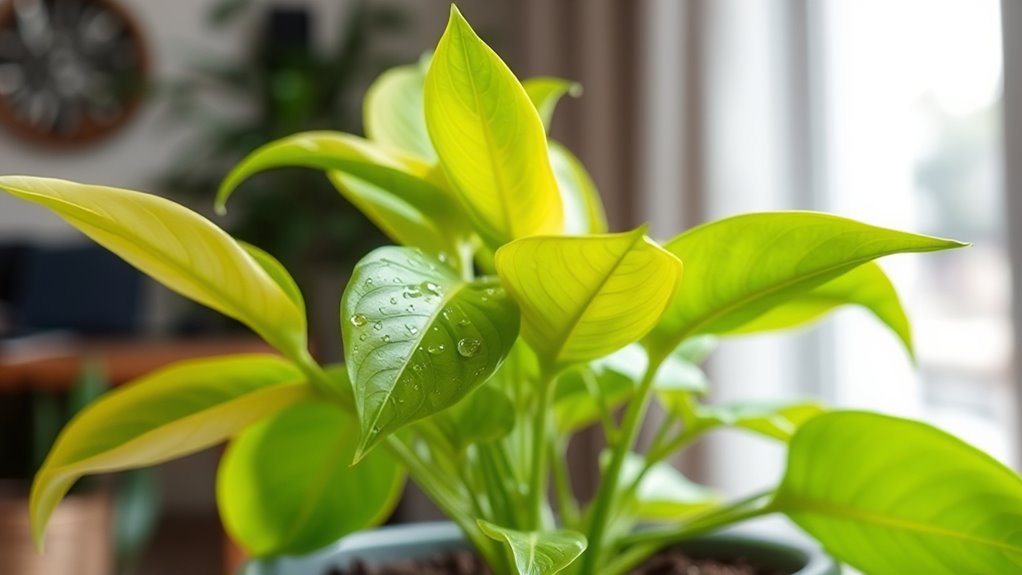
When you repot a houseplant, it’s common to see some yellowing leaves as the plant adjusts to its new environment. This happens because of transplant shock and soil adjustment, which can stress the plant. Root disturbance during repotting may also trigger yellowing leaves. Additionally, providing the right amount of light exposure can help minimize stress and promote recovery. Ensuring proper watering practices supports healthy root development and reduces further stress on the plant. Proper soil quality is essential to provide the necessary nutrients and support healthy growth. To help your plant recover:
- Avoid fertilizing for about a week to prevent additional stress.
- Water consistently but don’t overwater, especially during the recovery period.
- Provide bright, indirect light to aid in adaptation.
- Minimize additional disturbances while the plant stabilizes in its new environment.
- Being aware of retail hours can help you plan your visits for purchasing supplies that support plant health.
Understanding that yellowing leaves are temporary can ease your worries. With proper care, your plant will overcome this stress and resume healthy growth.
Frequently Asked Questions
How to Fix Yellow Leaves on Indoor Plants?
You can fix yellow leaves on your indoor plants by first checking their watering routine—only water when the top inch of soil feels dry.
Make sure they get enough bright, indirect light, and consider supplementing with grow lights if needed.
Inspect for pests or disease and treat accordingly.
Also, test the soil pH and fertilize with a balanced, water-soluble plant food to guarantee proper nutrients are available.
How to Tell if Yellow Leaves Are From Overwatering or Underwatering?
Imagine your plant throwing a pity party with yellow leaves as confetti. To tell if it’s overwatered or underwatered, check the soil first.
If it’s waterlogged and smells bad, it’s drowning in excess water.
If it’s dry and crumbly, it’s starving for moisture.
Feel the top inch; wet means overwatering, dry signals underwatering.
Adjust your watering accordingly, and your plant might just RSVP to life again.
Does Epsom Salt Help Yellow Leaves?
Yes, Epsom Salt can help with yellow leaves if magnesium deficiency is the cause. You should mix 1-2 teaspoons per gallon of water and apply it monthly.
This provides magnesium and sulfur, which are essential for healthy green foliage. However, make certain your plant actually needs these nutrients before using Epsom Salt, as overuse can cause imbalances.
Proper diagnosis is key to effective treatment.
How to Make Yellow Leaves Green Again?
While yellow leaves might seem beyond saving, you can turn them green again. First, correct underlying issues like watering habits, pH imbalance, or nutrient deficiencies.
Use a balanced, water-soluble fertilizer suited for your plant, and adjust light, humidity, and temperature to reduce stress.
Remove the most yellowed leaves to focus energy on new growth, and regularly test soil pH to make sure nutrients are accessible, helping your plant regain its vibrant green color.
Conclusion
Think of your houseplant as a delicate orchestra; when one instrument falters, the whole harmony suffers. I once overlooked a yellowing pothos, only to realize it was overwatered—like a singer struggling with a flat note. By tuning into its needs—checking drainage, soil, and environment—you can bring back its vibrant green. With patience and care, you’ll turn that dissonance into a lush, thriving masterpiece. Your plant’s health depends on your attentive, loving conduct.


